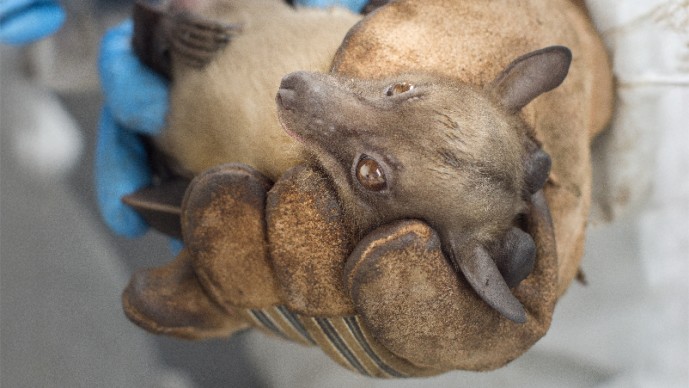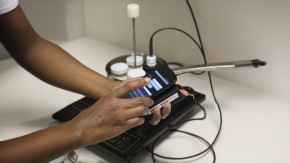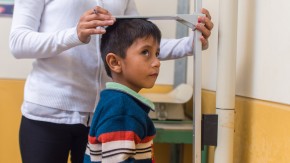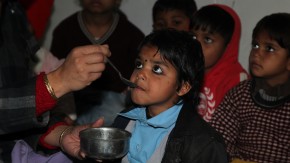
Photo: A GCE project in Madagascar is analyzing samples from undiagnosed fever patients and from bats to identify bat-derived viruses that cause human infectious diseases.
There are few things more frustrating than an unsolved mystery - especially when that mystery is why children get sick and die. That's why, in 2018, Grand Challenges Explorations (GCE) and the Chan-Zuckerberg Initiative (CZI) launched a partnership that promises to help uncover some of the major causes of undiagnosed newborn death worldwide. Together, we'll give healthcare workers around the globe the tools and training they need to solve the medical mysteries in their own backyards, helping children survive and thrive through infancy and beyond.
Every year, more than 2.5 million newborns die before they are one month old. There are three main reasons why. One is infection. Another is neonatal respiratory distress syndrome, a complication of premature birth in which a baby's lungs aren't developed enough to produce surfactant (a slippery liquid that coats the inside of the lungs, allowing them to fill with air). A third is birth asphyxia, or a lack of oxygen and blood flow to the brain, due to complications of labor and delivery.
For obvious reasons, the foundation's approach to reducing neonatal mortality is focused on solutions to these three problems, like inexpensive and simple-to-administer surfactant replacement, strategies for helping babies' brains avoid injury or recover function despite having been starved of oxygen, and new approaches to preventing life-threatening infection.
But it's not easy to treat an infection, much less prevent it, when you don't know what caused it. Even in developed countries like the U.S., we're not able to determine the cause of the majority of cases of life-threatening infection in newborns - and when we can, it's because it was something we already knew to look for.
In other words, our diagnostics have been biased. We take a sample of, say, cerebrospinal fluid from a sick person; we culture it in a lab; and we compare what grows to a catalog of pathogens we've already identified. If nothing grows, we can still try to detect known pathogens via residual DNA, RNA, or protein, but this can only be done for a few "usual suspect" pathogens for which we have built custom, costly detection tools. And if we don't deliberately seek something out, we won't find it - and because we don't know what else is out there that we're missing, we can't make new vaccines or antibiotics to target those things. The unsolved mystery stays unsolved.
Until now.
Now, thanks to cutting-edge, unbiased metagenomic sequencing technology, we can take that same sample of cerebrospinal fluid, amplify every shred of evidence of life we find there, sequence its genetic material, and map it, using a big, cloud-based computer, to all known forms of life in the world. We don't need to look for a match from that list of known pathogens anymore - we can just find out what's caused the infection.
And we're working alongside the CZ-Biohub in San Francisco, which has one of the most cutting-edge sequencing laboratories in the world, to share the knowledge and power to do this kind of unbiased sequencing - the Miss Marple of medical mysteries! - with hospitals all over the globe.
In 2018, the foundation's GCE team and CZI/CZ-B put out a collaborative call for proposals to labs and hospitals around the world: Come to San Francisco to learn the biochemistry and processing and informatics required to use CZI's user-friendly, open-source, open-access IDseq software, and then we'll pay for a sequencer, a sequencing technician, and all the reagents needed for 18 months of lab work at your home hospital.
The GCE call received almost 400 applications from all over the world. In the end, we chose 10: one in South America, five in Africa, and four in South Asia. First up are researchers from Cambodia, South Africa, and Madagascar.
The original pilot project that provided proof of concept and inspiration for the GCE began with an on-the-ground test of real-life unsolved mysteries from Bangladesh. For many years, doctors and scientists at the children's hospital in Dhaka have seen a high burden of meningitis, an inflammation of the membranes around the brain and spine usually caused by infectious pathogens. Dr. Samir Saha, the head of the microbiology laboratory there, has been archiving mystery samples for years in the hope that one day the technology would exist to be able to decipher the clues held in these freezers packed full of remnant cerebrospinal fluid from critically ill infants.
As part of a joint pilot project between the Discovery & Translational Sciences team at the Gates foundation and the CZ-Biohub, Dr. Saha's colleague (and daughter!) Dr. Senjuti Saha traveled to San Francisco to test a new, highly sensitive and unbiased sequencing technology for pathogen discovery at the CZ-Biohub. Dr. Saha brought with her about 100 samples for metagenomic sequencing and bioinformatic analysis, including multiple control samples and - importantly - 25 of the mystery meningitis samples.
The results, now published in mBio, were staggering. Nearly half the time, Dr. Saha was able to find the cause of the illness - and it was never something existing (biased) tests were already looking for. On the contrary; they were things nobody expected to cause meningitis at all, like the mumps virus, tetraparvovirus (a virus unknown even to most infectious disease specialists), and - most important of all - chikungunya, a mosquito-borne virus previously unconnected to neonatal meningitis.
Dr. Saha went back to Dhaka, developed a low-cost test just for the chikungunya virus, and analyzed 478 more meningitis mystery samples - 15 percent of which tested positive. Now we know: chikungunya can cause meningitis in newborn babies. And now that we know, we can do something with that knowledge - like prioritizing a vaccine for that disease, for instance, if this same result were to validate more broadly.
This is the key. We don't just want to solve mysteries for their own sake. We want answers that allow us to take action. This work creates the possibility of a future in which we know what's causing infections around the world and can optimize tools to fight them. That means we can save more lives - the greatest possible ending to any mystery.



